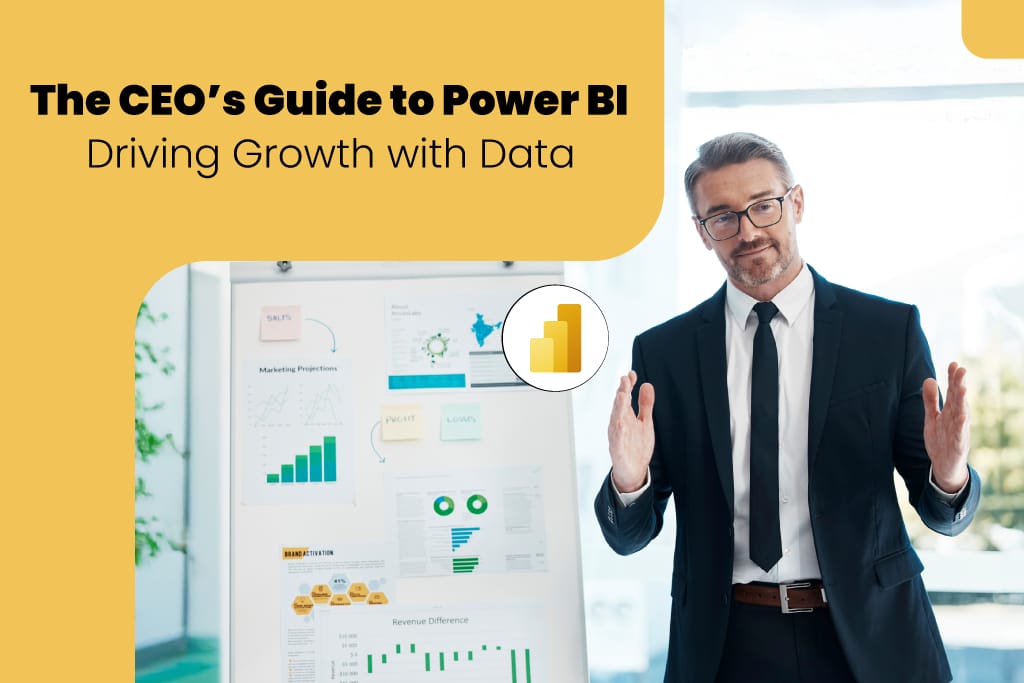These days, data isn’t just important but essential. As a CEO, your ability to make smart, timely decisions can be the difference between leading the market or falling behind the competition. That’s where Power BI comes in. It’s a strategic tool that helps you turn raw data into clear, actionable insights.
With Power BI, you can easily visualize your company’s key metrics, track performance in real time, and make data-driven decisions that move your business forward. Whether you’re refining your financial forecasts, sharpening your marketing strategies, or streamlining your supply chain, Power BI gives you the clarity and control you need.
This guide highlights the key features of Power BI and how CEOs can leverage this technology to drive growth and performance.
Key Features of Power BI
To get the most out of Power BI, it’s important to understand the features first. Let’s have a look:
- Seamless Data Connectivity: Power BI connects effortlessly to a wide range of data sources – from cloud platforms to on-premise systems. This gives you instant access to the necessary information.
- Customizable Dashboards: You can build interactive dashboards tailored to your strategic goals. Through these dashboards, you can monitor key performance indicators (KPIs) and stay focused on what matters most.
- Real-Time Reporting: Make decisions with confidence using real-time data. You can stay agile and respond quickly to fluctuations in the market.
- Advanced Analytics: You get the scope to tap into built-in AI and machine learning tools to uncover predictive insights. It’s all about planning with clarity.
- Collaboration Made Easy: Share reports and dashboards with your team and stakeholders in just a few clicks. Everyone stays aligned, informed, and ready to act.
How CEOs Use Power BI for Business Growth?
By choosing Power BI as your business intelligence tool, you unlock the full potential of your data. This enables informed decisions that drive your company’s growth and success. Here’s how:
- Enhanced Visibility Across Operations: Power BI pulls together data from every corner of your company – sales, finance, operations – into one easy-to-navigate dashboard. You get a real-time, bird’s-eye view of what’s happening, so you can spot issues early and seize opportunities faster.
- Better Decision-Making: You don’t have to rely on gut instincts anymore. With Power BI’s interactive dashboards, you can drill down into data to uncover trends, patterns, and anomalies. This deep analysis facilitates data-driven decision-making while giving you a competitive edge.
- Improved Strategic Planning: Since Power BI connects data across departments, you can know how your business is performing. This makes it easier to align your strategic goals with actual results.
- Cost Efficiency: Manual reporting is time-consuming and expensive. Power BI automates and streamlines the process. It delivers high-quality insights without the hefty price tag of traditional analytics tools.
- Empowering Your Team: Power BI puts data in the hands of your people – not just analysts. Team members of different departments can build their own reports and explore insights independently.
Implementing Power BI: A Step-by-Step Approach
Rolling out Power BI might feel difficult at first, but when you break it down into clear steps, it becomes a manageable journey. Here’s a straightforward path to get started:
1. Set Clear Business Goals
Begin by pinpointing where Power BI can make the biggest impact. Are you looking to tighten financial oversight? Boost sales performance? Streamline operations? Knowing your priorities helps shape how you build and use Power BI from the very first day.
2. Build a Solid Data Strategy
Power BI thrives on clean, consistent data. Make sure your data is accurate, well-organized, and ready to be integrated. A strong foundation here sets the stage for reliable insights.
3. Design Dashboards and Reports
Work with your team to create dashboards that highlight the metrics that matter most. The goal is to spotlight the KPIs that drive your strategy forward.
4. Train Your Team
It’s important that your internal teams understand how to use Power BI effectively. Provide training sessions to ensure that employees can create, interpret, and act on the data.
5. Monitor and Iterate
Implementing Power BI isn’t a one-time project; it’s an ongoing process. Once you’ve set up your dashboards, monitor them regularly. Look for areas where you can refine and improve the data or visualization. As your business grows, your Power BI setup should evolve to reflect new needs.
Use Cases of Power BI for CEOs
CEOs can apply Power BI across various aspects of their business. Here are some specific use cases:
- Financial Performance Tracking: Get a live snapshot of your company’s financial health. Power BI lets you track revenue, expenses, and profitability across departments in real time, so you can respond quickly and make smarter financial decisions.
- Sales and Marketing Insights: You can gain a deeper understanding of your sales pipeline, customer behavior, and marketing ROI. Power BI analyzes key performance metrics, thereby helping you identify growth opportunities.
- Operational Efficiency: You can monitor operations in real time to detect bottlenecks and inefficiencies. Power BI’s dashboards highlight areas for improvement.
- Employee and Resource Management: Use Power BI to track workforce performance, resource allocation, and productivity. This insight helps you optimize team performance and ensure you’re making the best use of available talent.
- Customer Insights and Experience: Use Power BI’s customer data analytics to understand what your customers want, how they behave, and what keeps them coming back. These insights help you personalize experiences, improve retention, and build lasting loyalty.
Overcoming Common Challenges with Power BI
As with any powerful tool, Power BI comes with its own set of challenges. Here’s how you can overcome some common issues that may arise while implementing Power BI:
- Data Quality and Integration Issues: Power BI is only as good as the data you feed it. Hence, your data needs to be clean and accurate. Also, you should establish a robust data governance strategy to maintain data consistency.
- Data Silos: Siloed data leads to fragmented decisions. Integrate your systems into Power BI to get a comprehensive, unified view of your operations.
- User Adoption: Change can be hard, especially when introducing new tools. To drive Power BI adoption, involve key stakeholders early on and offer hands-on training.
- Security Concerns: Security is non-negotiable. Use Power BI’s built-in features like role-based access and row-level security to control who sees what. Regular audits and clear access policies help you stay compliant and protect sensitive information.
The Future of Power BI
Power BI is evolving rapidly to meet the needs of modern leaders, and the future looks incredibly promising. Here are some trends to look out for:
- AI-Powered Analytics: Power BI is getting more intelligent. With deeper AI and machine learning integration, it can now reveal insights more accurately, predict trends, and flag potential risks before they become problems.
- Predictive Analytics: Looking back is useful, but looking ahead is game-changing. Power BI is shifting toward predictive analytics. You can forecast outcomes and take action early.
- Natural Language Processing (NLP): NLP is making Power BI more intuitive. You’ll soon be able to ask questions like “What were our top-selling products last quarter?” and get instant answers.
Conclusion
Power BI adoption is more than a mere tech upgrade. It’s a leadership shift. With this strategic asset, you can make decisions that drive real growth. It’s advisable to start small and align your data strategy with your business objectives. The more you lean into data-driven leadership, the more you’ll see the impact.
Reasons to Choose Power BI Development Services
When it comes to implementing Power BI effectively across your organization, partnering with experts is often the best choice. Here’s why you should choose Power BI development services:
- Custom Solutions: Experts design dashboards and reports that align with your business goals and KPIs.
- Seamless Integration: Power BI development services ensure smooth integration with existing data systems and tools.
- Advanced Analytics: Access to AI and machine learning capabilities for deeper, predictive insights.
- Ongoing Support: Continuous support and maintenance to adapt as your business evolves and new features become available.
- Enhanced Security: Implement robust data security features, ensuring that sensitive information is protected.
- Cost-Effective: Professional services streamline development, saving you time and reducing the costs associated with in-house development.








